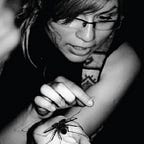Christmas Trees: Pine and PVC Needles
Generally ice or, rather, water, freezing at a below-zero temperature, increases in bulk when it solidifies. As a child, I was fascinated by a story of a hermetically sealed vessel, filled to the brim with water. If it were allowed to freeze, the water, at the moment of its transformation into ice, would shatter it, no matter how hard the metal from which it was constructed. Actually, of course, the water is no longer ‘water’ when it does it, but has become ice. But this was of no importance to me. What was important to a 6-year old is the image of the exploding bottle, sending shards of glass in every which way.
I won’t go into the details of my rather disappointing experiment with an empty wine bottle, water and a cork, but a few weeks later on one especially freezing winter day my dad came home with a frost-bite. He told me that when skin temperature drops low enough, ice crystals can form around and within the cells, freezing tissue and ultimately rupturing cells. I wondered if shards of exploded cell walls also fly in all possible directions.
Since then I was obsessed with living organisms that manage to not ‘explode’ in a freezing temperature. As a child I viewed them as super heroes with special powers and when I grew up, I began to study the cell structure and composition of Antarctic fish, Gray tree frogs, Painted turtles and other fascinating species that store ‘anti-freeze’ proteins in their bodies. As a side note, if you’ve never seen turtles on ice and how they stroke each other’s cheeks in courtship, you must immediately watch this video!
My parents always preferred pine tree to any other conifer for the holiday season and our home would always be filled with the delightful aromatic smell produced by the same mixture of organic compounds that help protect the tree from sub-freezing temperatures. So you can imagine my amusement when my partner took a polyvinyl chloride Christmas tree out of the storage and propped it up in our living room. This is the first time I saw an artificial tree get assembled. Naturally I plucked a few needles from it and threw them on the slide. By comparison, below the PVC needle is the actual pine leaf (both are magnified 100X):
It’s amusing how different the needle structures are and yet they appear similar on the surface. Overall, humans have gotten pretty good at mimicking the appearance of a natural object.
The PVC needle has its own reasoning behind the texture — a result of cost, function and manufacturing technique. Texture on a flat sheet of PVC provides rigidity — in a way it mimics a leaf of a deciduous tree. The needle’s corrugation pattern (i.e. change of its topography elevation) helps sheets of plastic obtain enhanced stiffness performance. Corrugation provides a sheet with additional rigidity in one or several directions without weight gain — another functional adaptation frequently found in natural and engineered specimens.
But this is where the similarity ends. After we cut both PVC and pine needles and looked at their cross sections, very different structures were revealed.
The pine leaf unraveled a whole world of structures, shapes, and functionalities that began its evolution ~150 million years ago. Something about needle-shaped leaves that fascinates me is that they are actually more efficient in gathering energy for the tree than broad leaves of deciduous trees. A study in Germany compared energy production in beech trees (which have broad, flat leaves) and Norway spruce trees (which have needles). It was found that the beech trees photosynthesize for 176 days in a year while the Norway spruce photosynthesize 260 days in a year. The bottom energy line was that with this increased time base for photosynthesis, the smaller leafed surface area of the Norway spruce was actually 58% more productive than the beech!
This, I think, is a really good lesson for designers and engineers when designing solar panels: maybe we don’t need giant bulky sheets on our roofs.
- Epidermis — The outer layer of the leaf one cell thick, protects the leaf from damage. It secretes a waxy layer that reduces evaporation, called cuticle.
- Stomata (singular: stoma) — The openings in epidermis that allow for the diffusion of carbon dioxide and oxygen as well as water. They are opened and closed by guard cells. Note that the stomata are sunk below the surface of the leaf; this reduces evaporation. Sunken stomata are one of many adaptations that help pine trees thrive in dry environments.
- Resin canals carry resin, which is a hydrocarbon-containing substance that helps protect the leaves from damage by insects.
- Phloem transports the sugars that are produced in photosynthesis from the leaves to the rest of the plant. The phloem cells are small and thin-walled; in this slide, as in many others, the phloem cells appear cyan.
- Xylem transports water and inorganic nutrients from the roots up to the rest of the plant; xylem cells are thick-walled and reinforced with lignin to withstand the necessary pressure. The xylem cells are stained red.
These are just some functionalities of the pine needle. I am very curious to see what the future unfolds for the artificial trees (i.e. solar panels, A/C units, filtration systems). The pine leaf/needle is capable of the efficient nutrition and gas exchange as well as protecting itself from extreme temperatures, dry climates, and parasites. A lot of similar capabilities exist in engineering already, it’s only a matter of bringing such functionalities to meso- and micro-scale structures.
